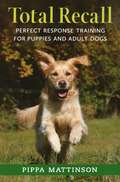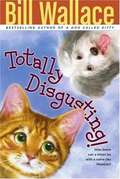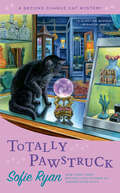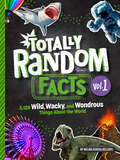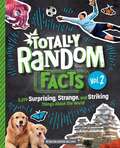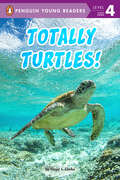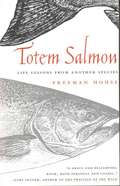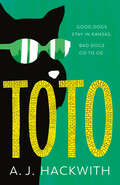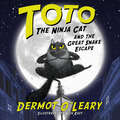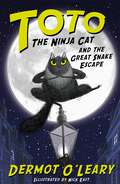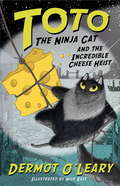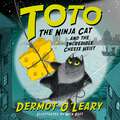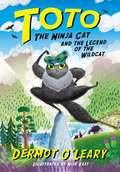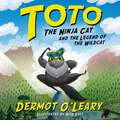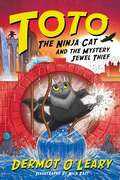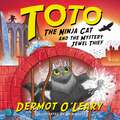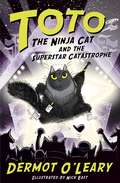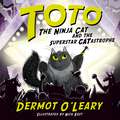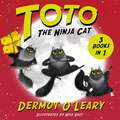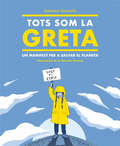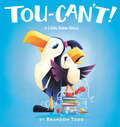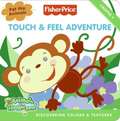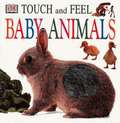- Table View
- List View
Total Recall: Perfect Response Training for Puppies and Adult Dogs
by Pippa MattinsonLearn how to use modern reward-based dog training methods effectively. "Total Recall" walks you step-by-step through the process of creating a powerful and permanent recall, in all manner of different and distracting situations. Contains photo and chart descriptions.
Totally Disgusting!
by Bill WallaceWhat kind of a name is Mewkiss? The kitten loves his person, Jessica, but he had hoped for a name like Fearless or Rat killer. It's hard to be brave with such a totally disgusting name. Even Barkus, a know-nothing puppy, calls Mewkiss a coward.
Totally Fun Things to Do with Your Dog
by Maxine RockGames and activities for kids and canines. Here's a great way to teach a dog some new tricks. With the super ideas and activities in this book, there's no end to the fun you'll have playing with your favorite four-legged friend. From shooting hoops to jumping through hoops, from taking a photo to taking a shower, Totally Fun Things to Do with Your Dog has an amazing array of activities you can share. Discover new variations on playing catch and fetch, or teach your dog to play hide and seek. You can even throw a special party for your special pooch-pal. Basic training tips are also included along with fascinating facts about dogs.
Totally Pawstruck (Second Chance Cat Mystery #9)
by Sofie RyanSecondhand store owner Sarah Grayson and her inquisitive rescue cat, Elvis, will need to close the book on a killer in the newest installment of this charming New York Times bestselling series. Although Sarah Grayson is often tending to the contained chaos of her delightful secondhand store in North Harbor, Maine, plus dealing with the quirky personality of her rescue cat, Elvis, she still takes an occasional night off. But her evening out comes to an abrupt end when Sarah discovers Stella Hall, a member of the library board, standing over a body in the street. Although Stella admits that she and the victim had fought about several things including library funding, she is adamant that she is innocent and the real killer is on the loose. Sarah is eager to help, but even with the assistance of Charlotte&’s Angels, the senior citizen detectives who rent out part of her shop, there is still a vast amount of circumstantial evidence linking Stella to the crime. The odds may be stacked against them, but Sarah and Elvis, along with the Angels, will work hard to check out the suspects and catch a killer.
Totally Random Facts Volume 1: 3,128 Wild, Wacky, and Wondrous Things About the World (Totally Random Facts #1)
by Melina Gerosa BellowsDID YOU KNOW? Dragonflies can see in all directions at once. Cats have a vocabulary of 14 words. And golf balls were originally made from—wait for it—cow&’s eyeballs.Fantastic facts and incredible images come to life in this big, beautiful hardcover book that brings the best of our wonderfully wild world right into kids' hands!The first volume of our beloved TOTALLY RANDOM FACTS series shows kids that the world is a truly amazing place! With literally thousands of wild, weird, and wonderfully random facts about anything and everything, this uber-giftable hardcover pairs amazing photography and cool design with a wealth of intriguing information to leave kids amazed and amused. From the depths of the oceans to the outer reaches of space, if your kid is interested in it, there's a Totally Random Fact about it!
Totally Random Facts Volume 2: 3,219 Surprising, Strange, and Striking Things About the World (Totally Random Facts #2)
by Melina Gerosa BellowsDID YOU KNOW? Male seahorses give birth, not females. Hershey's kisses used to be square. Squid have nine brains--and the central one's shaped like a donut, with a hole in the middle! Even MORE fantastic facts and incredible images come to life in the second volume of the kid-favorite TOTALLY RANDOM FACTS series.There is a wild world of VERY random information out there! This second volume of the beloved Totally Random Facts series rounds up another 3000-plus of those surprising, strange, and striking nuggets of information. Covering everything from cuddly pets to venomous spiders and exoplanets to undersea trenches, this uber-giftable hardcover showcases amazing photography, cool design, and weird-but-true information. If your trivia-phile is interested in it, there's a Totally Random Fact about it!
Totally Turtles! (Penguin Young Readers, Level 4)
by Ginjer L. ClarkeLearn about turtles and their many talents in this nonfiction leveled reader perfect for kids interested in these shelled creatures and their lives on land and in the water!Did you know that leatherback turtles can weigh up to two thousand pounds? Or that the Florida softshell turtle can breathe through its snout and its skin? Turtles have been around for millions of years and we&’re still learning more about them! With simple language and vivid photographs, Totally Turtles! is perfect for emerging readers curious about turtles and how they have managed to adapt, survive, and thrive for so long.
Totem Salmon: Life Lessons from Another Species
by Freeman HousePart lyrical natural history, part social and philosophical manifesto, Totem Salmon tells the story of a determined band of locals who've worked for over two decades to save one of the last purely native species of salmon in California. The book-call it the zen of salmon restoration-traces the evolution of the Mattole River Valley community in northern California as it learns to undo the results of rapacious logging practices; to invent ways to trap wild salmon for propagation; and to forge alliances between people who sometimes agree on only one thing-that there is nothing on earth like a Mattole king salmon. House writes from streamside: "I think I can hear through the cascades of sound a systematic plop, plop, plop, as if pieces of fruit are being dropped into the water. Sometimes this is the sound of a fish searching for the opening upstream; sometimes it is not. I breathe quietly and wait. " Freeman House's writing about fish and fishing is erotic, deeply observed, and simply some of the best writing on the subject in recent literature. House tells the story of the annual fishing rituals of the indigenous peoples of the Klamath River in northern California, one that relies on little-known early ethnographic studies and on indigenous voices-a remarkable story of self-regulation that unites people and place. And his riffs on the colorful early history of American hatcheries, on property rights, and on the "happiness of the state" show precisely why he's considered a West Coast visionary. Petitions to list a dozen West Coast salmon runs under the provisions of the Endangered Species Act make saving salmon an issue poised to consume the Pacific West. "Never before, said Federal officials, has so much land or so many people been given notice that they will have to alter their lives to restore a wild species" (New York Times, 2/27/98). Totem Salmon is set to become the essential read for this newest chapter in our relations with other wild things.
Toto
by A. J. HackwithThe true hero of The Wizard of Oz takes center stage in this brilliant, delightfully snarky reimagining from the author of The Library of the Unwritten.I was mostly a Good Dog until they sold me out to animal control, okay?But if it&’s a choice between Oz, with its creepy little singing dudes, and being behind bars in gray old Kansas, I&’ll choose the place where animals talk and run the show for now, thanks.It&’s not my fault that the kid is stuck here too, or that she stumbled into a tug-of-war over a pair of slippers that don&’t even taste good. Now one witch in good eyeliner calls her pretty and we&’re off on a quest? Teenagers.I try to tell her she&’s falling in with the wrong crowd when she befriends a freaking hedge wizard made of straw, that blue jay with revolutionary aspirations, and the walking tin can. Still, I&’m not one to judge when there&’s the small matter of a coup in the Forest Kingdom.... Look, something really stinks in Oz, and this Wizard guy and the witches positively reek of it. As usual, it&’s going to be up to a sensible little dog to do a big dog&’s job and get to the bottom of it.And trust me: Little dogs can get away with anything.
Toto the Ninja Cat and the Great Snake Escape: Book 1 (Toto #1)
by Dermot O’LearyMeet Toto: she's no ordinary cat, and she can't wait to have an adventure with you! Join Toto for a funny animal escapade written by one of the UK's best-loved broadcasters. For fans of The Aristocats, The Secret Life of Pets, 101 Dalmatians and Atticus Claw Breaks the Law. Toto the cat and her brother Silver live footloose and fancy-free in a townhouse in London. Toto is almost totally blind, and learned to trust her senses from a ninja cat-master who taught her back in Italy where they were born. By day, Toto and Silver seem to be ordinary cats, but by night, they love to have adventures! One evening, news reaches Toto that a king cobra has escaped from London Zoo! Together with help from a very posh rat and two hungry tigers, Toto and Silver must investigate. Can they find the giant snake, before it's too late? Dermot says: 'The idea for Toto first came to me when my wife and I rescued two stray cats from an olive grove in Italy. One of them, Toto, has been blind from birth, but we quickly realised she had ninja-like reactions. Like a lot of cat owners (or cat servants), we like to imagine our pets having secret lives when we're out or asleep. So before I knew it I was writing about Toto and her brother Silver's nocturnal adventures around London. I really hope that children who pick it up enjoy reading the adventures of our little Italian underdog (cat).'(P) 2017 Hodder Children's Books
Toto the Ninja Cat and the Great Snake Escape: Book 1 (Toto #1)
by Dermot O’LearyFrom bestselling children's author and TV broadcaster, Dermot O'Leary, comes an action-packed new adventure from Toto the ninja cat - a snake has escaped London Zoo and it's up to her to find it! Purrfect for fans of The Aristocats, The Secret Life of Pets and Atticus Claw Breaks the Law.Toto the cat and her brother Silver live footloose and fancy-free in a townhouse in London. Toto is almost totally blind, and learned to trust her senses from a ninja cat-master who taught her back in Italy where they were born. By day, Toto and Silver seem to be ordinary cats, but by night, they love to have adventures! One evening, news reaches Toto that a king cobra has escaped from London Zoo! Together with help from a very posh cat and two hungry tigers, Toto and Silver must investigate. Can they find the giant snake, before it's too late?Ideal for reading aloud or for children to curl up with and read alone, the story features brilliant black and white illustrations throughout by Nick East. With gentle themes of friendship, inclusivity and winning in the face of adversity, this is a hilarious must-read for all animal-loving kids! Dermot says: 'The idea for Toto first came to me when my wife and I rescued two stray cats from an olive grove in Italy. One of them, Toto, has been blind from birth, but we quickly realised she had ninja-like reactions. Like a lot of cat owners (or cat servants), we like to imagine our pets having secret lives when we're out or asleep. So before I knew it I was writing about Toto and her brother Silver's nocturnal adventures around London. I really hope that children who pick it up enjoy reading the adventures of our little Italian underdog (cat).'Have you seen Toto's other adventures? The Incredible Cheese Heist, The Superstar Catastrophe, The Mystery Jewel Thief and The Legend of the Wildcat are out now, and make perfect gifts for young readers.For more animal adventures, discover Wings of Glory. Can one tiny bird help to win a world war? A funny action-adventure story with a feathery twist, from the bestselling children's author of Toto the Ninja Cat, Dermot O'Leary, with glorious illustrations throughout by Claire Powell.
Toto the Ninja Cat and the Incredible Cheese Heist: Book 2 (Toto #2)
by Dermot O’LearyToto is no ordinary cat, and she can't wait for you to join her on her SECOND ninja adventure! From one of the UK's best-loved broadcasters, purrfect for fans of The Aristocats, The Secret Life of Pets and Atticus Claw Breaks the Law. Toto, the amazing ninja cat, is back and cooler than ever! Toto is almost blind, but that doesn't stop her having brilliant adventures. Something CAT-ASTROPHIC has happened: ALL the cheese in the world has been stolen. Join Toto, her brother Silver and their best-friend Catface on a secret mission to save the day. Toto is going to need all her ninja skills to defeat the fur-midable cheese thief ...Ideal for reading aloud or for children to curl up with and read alone, the story features brilliant black and white illustrations throughout. With gentle themes of friendship, inclusivity and winning in the face of adversity, this is a hilarious must-read for all animal-loving kids! Dermot says: 'The idea for Toto first came to me when my wife and I rescued two stray cats from an olive grove in Italy. One of them, Toto, has been blind from birth, but we quickly realised she had ninja-like reactions. Like a lot of cat owners (or cat servants), we like to imagine our pets having secret lives when we're out or asleep. So before I knew it I was writing about Toto and her brother Silver's nocturnal adventures around London. I really hope that children who pick it up enjoy reading the adventures of our little Italian underdog (cat).'Have you seen Toto's other adventures? The Great Snake Escape and The Superstar Catastrophe are out now, and make perfect Christmas gifts for young readers.
Toto the Ninja Cat and the Incredible Cheese Heist: Book 2 (Toto #2)
by Dermot O’LearyToto is no ordinary cat, and she can't wait for you to join her on her second ninja adventure! A funny animal escapade written and read by one of the UK's best-loved broadcasters. For fans of The Aristocats, The Secret Life of Pets, 101 Dalmatians and Atticus Claw Breaks the Law. A hilarious story for all animal-loving kids, with gentle themes of friendship, inclusivity and winning in the face of adversity.Toto, the amazing ninja cat, is back and cooler than ever!Something CAT-ASTROPHIC has happened: ALL the cheese in the world has been stolen. Join Toto, her brother Silver and their best-friend Catface on a secret mission to save the day. Toto is going to need all her ninja skills to defeat the fur-midable cheese thief ...Dermot says: 'The idea for Toto first came to me when my wife and I rescued two stray cats from an olive grove in Italy. One of them, Toto, has been blind from birth, but we quickly realised she had ninja-like reactions. Like a lot of cat owners (or cat servants), we like to imagine our pets having secret lives when we're out or asleep. So before I knew it I was writing about Toto and her brother Silver's nocturnal adventures around London. I really hope that children who pick it up enjoy reading the adventures of our little Italian underdog (cat).'(P) 2018 Hodder Children's Books
Toto the Ninja Cat and the Legend of the Wildcat: Book 5 (Toto #5)
by Dermot O’LearyToto is no ordinary cat, and she can't wait for you to join her on her FIFTH ninja adventure! From one of the UK's best-loved broadcasters.Toto's brothers, Silver and Socks, and their best friend Catface have just been made Deputy Ninja Cats! But while celebrating, they accidentally break a boat belonging to a very important cat and find themselves heading north to a bootcamp for naughty animals.Deep in the Scottish Highlands, they must climb mountains, paddle leaky canoes and prove that they can work as a team. But something isn't quite right at the bootcamp, and Toto's ninja senses are on high alert ...There is a local legend of a super-strong wildcat, destined to raise an army and take over all of Scotland. Toto knows she must find out more, but danger is lurking at every turn. Can she find the mysterious wildcat, before it's too late?Ideal for reading aloud or for children to curl up with and read alone, the story features brilliant black and white illustrations throughout. With themes of friendship, inclusivity and winning in the face of adversity, this is a hilarious must-read for all animal-loving kids! The hardback edition features paw-print endpapers and an inner-cover hidden beneath the jacket - making it a brilliant gift for young readers. From one of the UK's best-loved broadcasters, theToto series is purrfect for fans of The Aristocats, The Secret Life of Pets and Atticus Claw Breaks the Law. Dermot says: 'The idea for Toto first came to me when my wife and I rescued two stray cats from an olive grove in Italy. One of them, Toto, has been blind from birth, but we quickly realised she had ninja-like reactions. Like a lot of cat owners (or cat servants), we like to imagine our pets having secret lives when we're out or asleep. So before I knew it I was writing about Toto and her brother Silver's nocturnal adventures around London. I really hope that children who pick it up enjoy reading the adventures of our little Italian underdog (cat).'Toto's other adventures include: The Great Snake Escape, The Incredible Cheese Heist, The Superstar Catastrophe and The Mystery Jewel Thief
Toto the Ninja Cat and the Legend of the Wildcat: Book 5 (Toto #5)
by Dermot O’LearyToto is no ordinary cat, and she can't wait for you to join her on her FIFTH ninja adventure! From one of the UK's best-loved broadcasters.Toto's brothers, Silver and Socks, and their best friend Catface have just been made Deputy Ninja Cats! But while celebrating, they accidentally break a boat belonging to a very important cat and find themselves heading north to a bootcamp for naughty animals.Deep in the Scottish Highlands, they must climb mountains, paddle leaky canoes and prove that they can work as a team. But something isn't quite right at the bootcamp, and Toto's ninja senses are on high alert ...There is a local legend of a super-strong wildcat, destined to raise an army and take over all of Scotland. Toto knows she must find out more, but danger is lurking at every turn. Can she find the mysterious wildcat, before it's too late?Ideal for reading aloud or for children to curl up with and read alone, the story features brilliant black and white illustrations throughout. With themes of friendship, inclusivity and winning in the face of adversity, this is a hilarious must-read for all animal-loving kids! The hardback edition features paw-print endpapers and an inner-cover hidden beneath the jacket - making it a brilliant gift for young readers. From one of the UK's best-loved broadcasters, theToto series is purrfect for fans of The Aristocats, The Secret Life of Pets and Atticus Claw Breaks the Law. Dermot says: 'The idea for Toto first came to me when my wife and I rescued two stray cats from an olive grove in Italy. One of them, Toto, has been blind from birth, but we quickly realised she had ninja-like reactions. Like a lot of cat owners (or cat servants), we like to imagine our pets having secret lives when we're out or asleep. So before I knew it I was writing about Toto and her brother Silver's nocturnal adventures around London. I really hope that children who pick it up enjoy reading the adventures of our little Italian underdog (cat).'Toto's other adventures include: The Great Snake Escape, The Incredible Cheese Heist, The Superstar Catastrophe and The Mystery Jewel Thief
Toto the Ninja Cat and the Mystery Jewel Thief: Book 4 (Toto #4)
by Dermot O’LearyToto is no ordinary cat, and she can't wait for you to join her on her FOURTH ninja adventure! From one of the UK's best-loved broadcasters, purrfect for fans of The Aristocats, The Secret Life of Pets and Atticus Claw Breaks the Law. Toto and her friends are due to be looking after the French ambassador on a day of sightseeing, finishing at the Tower of London to see the animal world's crown jewels: a sacred diamond cat collar. But when they arrive, the collar has disappeared - and what's worse, it looks like Toto's boss Larry is responsible, with Toto as his accomplice! Toto is almost arrested, but she escapes to try and get to the bottom of the mystery and clear her name. She and her friends will have to follow some strange clues that will take them to a secret bookshop, Buckingham Palace and the rats' underground city in the sewers... Can they defeat an unexpected villain and bring the thief to justice?Ideal for reading aloud or for children to curl up with and read alone, the story features brilliant black and white illustrations throughout. With gentle themes of friendship, inclusivity and winning in the face of adversity, this is a hilarious must-read for all animal-loving kids! Dermot says: 'The idea for Toto first came to me when my wife and I rescued two stray cats from an olive grove in Italy. One of them, Toto, has been blind from birth, but we quickly realised she had ninja-like reactions. Like a lot of cat owners (or cat servants), we like to imagine our pets having secret lives when we're out or asleep. So before I knew it I was writing about Toto and her brother Silver's nocturnal adventures around London. I really hope that children who pick it up enjoy reading the adventures of our little Italian underdog (cat).'Have you read Toto's other adventures: The Great Snake Escape, The Incredible Cheese Heist and The Superstar Catastrophe?
Toto the Ninja Cat and the Mystery Jewel Thief: Book 4 (Toto #4)
by Dermot O’LearyToto is no ordinary cat, and she can't wait for you to join her on her FOURTH ninja adventure! From one of the UK's best-loved broadcasters, purrfect for fans of The Aristocats, The Secret Life of Pets and Atticus Claw Breaks the Law. Toto and her friends are due to be looking after the French ambassador on a day of sightseeing, finishing at the Tower of London to see the animal world's crown jewels: a sacred diamond cat collar. But when they arrive, the collar has disappeared - and what's worse, it looks like Toto is responsible! Toto is almost arrested, but she escapes to try and get to the bottom of the mystery and clear her name. She and her friends will have to follow some strange clues that will take them to a secret bookshop, Buckingham Palace and the rats' underground city in the sewers... Can they defeat an unexpected villain and bring the thief to justice?Ideal for reading aloud or for children to curl up with and read alone. With gentle themes of friendship, inclusivity and winning in the face of adversity, this is a hilarious must-read for all animal-loving kids! Dermot says: 'The idea for Toto first came to me when my wife and I rescued two stray cats from an olive grove in Italy. One of them, Toto, has been blind from birth, but we quickly realised she had ninja-like reactions. Like a lot of cat owners (or cat servants), we like to imagine our pets having secret lives when we're out or asleep. So before I knew it I was writing about Toto and her brother Silver's nocturnal adventures around London. I really hope that children who pick it up enjoy reading the adventures of our little Italian underdog (cat).'Have you read Toto's other adventures: The Great Snake Escape, The Incredible Cheese Heist and The Superstar Catastrophe?(P)2020 Hodder & Stoughton Limited
Toto the Ninja Cat and the Superstar Catastrophe: Book 3 (Toto #3)
by Dermot O’LearyToto is no ordinary cat, and she can't wait for you to join her on her THIRD ninja adventure! After months of keeping London safe from notorious animal bad guys, Toto the Ninja Cat is going on a well-earned holiday to the world's most famous music festival - Catstonbury!But a villain has a dastardly plan to hypnotise the crowd when a world-famous band is on stage, turning them into evil minions. How can Toto possibly prevent the catastrophe when everyone thinks the band is the cat's pyjamas? It will take all Toto's ninja skills - and some help from a friendly otter - to save the day...Ideal for reading aloud or for children to curl up with and read alone, the story features brilliant black and white illustrations throughout. With gentle themes of friendship, inclusivity and winning in the face of adversity, this is a hilarious must-read for all animal-loving kids! The hardback edition features paw-print endpapers and a superstar inner-cover hidden beneath the jacket - making it a brilliant gift for young readers. From one of the UK's best-loved broadcasters, theToto series is purrfect for fans of The Aristocats, The Secret Life of Pets and Atticus Claw Breaks the Law. Dermot says: 'The idea for Toto first came to me when my wife and I rescued two stray cats from an olive grove in Italy. One of them, Toto, has been blind from birth, but we quickly realised she had ninja-like reactions. Like a lot of cat owners (or cat servants), we like to imagine our pets having secret lives when we're out or asleep. So before I knew it I was writing about Toto and her brother Silver's nocturnal adventures around London. I really hope that children who pick it up enjoy reading the adventures of our little Italian underdog (cat).'Have you read Toto's other adventures: The Great Snake Escape and The Incredible Cheese Heist?
Toto the Ninja Cat and the Superstar Catastrophe: Book 3 (Toto #3)
by Dermot O’LearyToto is no ordinary cat, and she can't wait for you to join her on her THIRD ninja adventure! From one of the UK's best-loved broadcasters, purrfect for fans of The Aristocats, The Secret Life of Pets and Atticus Claw Breaks the Law. After months of keeping London safe from notorious animal bad guys, Toto the Ninja Cat is going on a well-earned holiday to the world's most famous music festival - Catstonbury!But a villain has a dastardly plan to hypnotise the crowd when a world-famous band is on stage, turning them into evil minions. How can Toto possibly prevent the catastrophe when everyone thinks the band is the cat's pyjamas? It will take all Toto's ninja skills - and some help from a friendly otter - to save the day...Dermot says: 'The idea for Toto first came to me when my wife and I rescued two stray cats from an olive grove in Italy. One of them, Toto, has been blind from birth, but we quickly realised she had ninja-like reactions. Like a lot of cat owners (or cat servants), we like to imagine our pets having secret lives when we're out or asleep. So before I knew it I was writing about Toto and her brother Silver's nocturnal adventures around London. I really hope that children who pick it up enjoy reading the adventures of our little Italian underdog (cat).'Have you heard Toto's other adventures: The Great Snake Escape and The Incredible Cheese Heist?(P)2019 Hodder & Stoughton Limited
Toto the Ninja Cat: Books 1-3
by Dermot O’LearyMeet Toto: she's no ordinary cat, and she can't wait to have an adventure with you! The totally paw-some collection of Books 1-3.Join Toto for funny animal escapades written by one of the UK's best-loved broadcasters. For fans of The Aristocats, The Secret Life of Pets, 101 Dalmatians and Atticus Claw Breaks the Law.Toto the cat and her brother Silver live footloose and fancy-free in a townhouse in London. Toto is almost totally blind, and learned to trust her senses from a ninja cat-master who taught her back in Italy where they were born. By day, Toto and Silver seem to be ordinary cats, but by night, they love to have adventures!Book 1: Toto the Ninja Cat and the Great Snake EscapeOne evening, news reaches Toto that a king cobra has escaped from London Zoo! Together with help from a very posh cat and two hungry tigers, Toto and Silver must investigate. Can they find the giant snake, before it's too late?Book 2: Toto the Ninja Cat and the Incredible Cheese HeistSomething CAT-ASTROPHIC has happened: ALL the cheese in the world has been stolen. Join Toto, her brother Silver and their best-friend Catface on a secret mission to save the day. Toto is going to need all her ninja skills to defeat the fur-midable cheese thief ...Book 3: Toto the Ninja Cat and the Superstar CatastropheAfter months of keeping London safe from notorious animal bad guys, Toto the Ninja Cat is going on a well-earned holiday to the world's most famous music festival - Catstonbury! But a villain has a dastardly plan to hypnotise the crowd when a world-famous band is on stage, turning them into evil minions. How can Toto possibly prevent the catastrophe when everyone thinks the band is the cat's pyjamas?
Tots som la Greta: Un manifest per a salvar el planeta
by Valentina GianellaTots som la Greta, i només nosaltres podem salvar el planeta. Què és el canvi climàtic?L'hem causat nosaltres?Quines conseqüències té?Som a temps de solucionar-ho? Amb tot just setze anys, la Greta no solament s'ha fet aquestes preguntes, sinó que ha aconseguit mobilitzar milions de joves d'arreu del món per protegir el nostre planeta i projectar un futur ple d'esperança. Si les seves idees et resulten inspiradores, ara és el moment d'unir-te a la missió més important de la nostra història: salvar el planeta del canvi climàtic.
Tou-Can't!: A Little Sister Story
by Brandon ToddA funny, heartwarming story about one little sister who learns that, big or little, there's plenty of love to go around.All one little toucan wants is to be big like her sister, and to get to do all the things her big sister can do. Tie her own shoes? She tou-can't. Make her own breakfast? She tou-can't! Read her own books? She tou-can't, tou-can't, tou-can't!!!But when her big sister gets a cold and needs some help, the tables are turned, and our little bird sister learns just how helpful she can actually be.In this sweet and playful sister story, it's the little things that matter the most. Praise for Tou-Can't: "Sisterly affection and admiration sweetly serves to strengthen the rapport between siblings." --Kirkus Reviews
Toucans (Nature's Children)
by Lorien KiteDescribes the physical features, habits and habitat of this bird of the tropics with the enormous beak.
Touch and Feel Adventure: Discovering Colors and Textures (Fisher-Price: Animals of the Rainforest)
by Alexis BaradBABY WILL LOVE DISCOVERING THE RAINFOREST BY TOUCHING REALISTIC TEXTURES. You can point out colors, too, as you introduce Baby to different furry, bumpy, and fuzzy animal friends.
Touch and Feel Baby Animals
by DkCome inside and discover the different textures of adorable baby animals.
